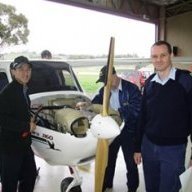G'day all,
To introduce myself, I hold a student licence with RAAus and have had a great time so far training in a Jabiru at The Oaks, training with John & Dave since last July. I have currently clocked up about 15 hrs flying time with them while I was living at Camden. I was able to do my first full nav exercise from The Oaks with Dave just before Christmas.
A 'career change' of sorts has seen me move 'South of the border' in the last few weeks though!
From February 08 I will be 'based' at Coldstream Airport as an Engineering Instructor, assisting with the engineering training programme at the Mission Aviation Centre located there. I suspect this new role is going to keep me busy for some time, however I am keen to complete my RAAus Pilot Licence as soon as time permits. Not having lived in VIC before I have no idea of what options exist in my new area for completing my training. Does anyone have recommendations / tips on the options that may exist for completing this training close to me.
Also, I am aware that some Ultralight activity occurs at Coldstream, and so would love to meet any one else who flys from there. Send me a reply, or just drop in and ask for Justin at 'MAC' from next week. (4-2-08)
Regards.







